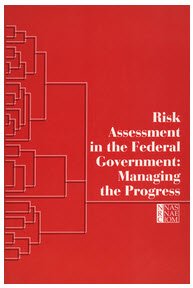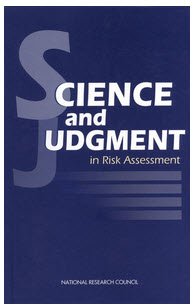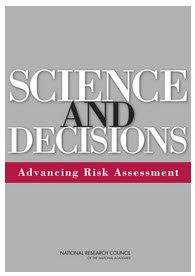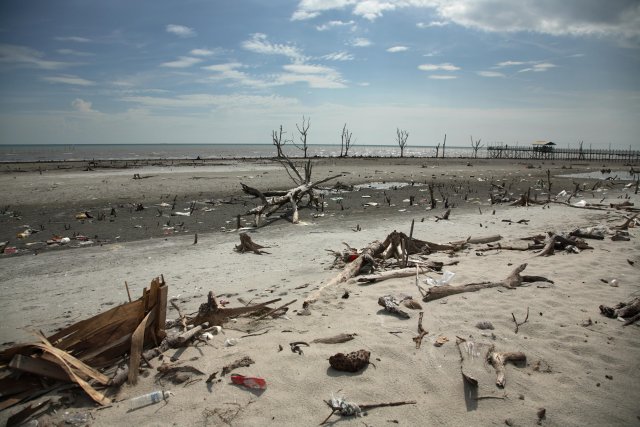About Risk Assessment
On this page:
Learn about Risk Assessment
A brief introduction to risk assessment is presented below. If you have questions after reviewing this page and its links, please use the “Contact Us” form, linked on this page, for assistance.
While there are many definitions of the word risk, EPA considers risk to be the chance of harmful effects to human health or to ecological systems resulting from exposure to an environmental stressor.
A stressor is any physical, chemical, or biological entity that can induce an adverse effect in humans or ecosystems. Stressors may adversely affect specific natural resources or entire ecosystems, including plants and animals, as well as the environment with which they interact.
Risk Assessment Basics
EPA uses risk assessment to characterize the nature and magnitude of risks to human health for various populations, for example residents, recreational visitors, both children and adults. EPA also estimates risks to ecological receptors, including plants, birds, other wildlife, and aquatic life. The risks might be from specific chemical contaminants such as mercury or mixtures of many chemicals such as in oil spills. Other types of stressors include disease-causing microbial agents or stressful conditions such as anoxia (lack of oxygen) in surface waters.
At EPA, environmental risk assessments typically fall into one of two areas:
- Human Health
- Ecological
Following a planning and scoping stage, where the purpose and scope of a risk assessment is decided, the risk assessment process usually begins by collecting measurements that characterize the nature and extent of the hazard in the environment. For example, chemical concentrations in soils could be measured around the source of a spill. Information needed to predict how the contaminants may behave in the future also could be collected. Here are some useful links to get started:
Based on the results of the planning and scoping phase, the risk assessor evaluates the frequency and magnitude of human and ecological exposures that may occur. Multiple lines of evidence are used to estimate potential consequences of contact with the contaminated medium, both now and in the future. Both the nature and extent of exposure and the effects of a stressor on humans or ecosystems are considered together. To characterize risks, the assessor predicts the probability, nature, and magnitude of the adverse effects that might occur.
Risk assessments should be based on a very strong knowledge base. Reliable and complete data on the nature and extent of contamination or occurrence of other stressor would be ideal. Understanding the movement and fate of chemicals, microbes, or other agents in the environment is needed. The risk assessor obtains available information that quantifies the relationships between the magnitude and frequency of human and ecological exposure and adverse outcomes.
In real life, however, information is usually limited for one or more of these key information needs. This means that risk assessors often must estimate exposures and use judgment to calculate risks. Consequently, all risk estimates include uncertainty. For this reason, a key part of all good risk assessments is a fair and open presentation of the uncertainties, including data gaps and limitations of models used to estimate exposure and effects.
The final phase of the assessment, risk characterization, includes both quantitative and qualitative descriptions of risk. The assessor clearly characterizes how reliable (or how unreliable) the resulting risk estimates really are. In general, where information is lacking, assessors use health protective assumptions, particularly in the early stages of a risk assessment.
Risk managers then use this information to help them decide how to protect humans and the environment from contaminants or other stressors. Note that “risk managers” can be federal or state officials whose job it is to protect the environment, business leaders who work at companies that can impact the environment, or private citizens who are making decisions regarding risk. The risk managers can conclude that more information is needed to reduce uncertainty in key factors driving risks and can request further data collection and a refined assessment.
Thus, a risk assessment often is an iterative process. The assessors screen initial information to identify the factors that are likely to most influence risk. Researchers can identify and fill data gaps as feasible to refine their assessment of risk. With better estimates, the risk assessors and risk managers might further refine the scope of the risk assessment, which can guide further data collection or more realistic assumptions.
Resources
- This is Superfund: A Community Guide To EPA's Superfund Program (12 pp, 1.2 Mb, About PDF)
- Superfund Today: Focus on Revisions to Superfund's Risk Assessment Guidance (1999) (2 pp, 50 K, About PDF)
- Risk-Screening Environmental Indicators (RSEI) Model- Use this model to explore data on releases of toxic substances from industrial facilities, to model how they might move through the environment, and to identify potential human exposures.
Risk Assessment Terminology
Most risk assessment terminology can be found in the Risk Assessment Glossary, but below we include the meaning behind "variability","uncertainty", and "probabilistic modeling."
VariabilityThis refers to a natural range of variation in environmental conditions and in responses of organisms to stressors. refers to a natural range of variation in environmental conditions and in responses of organisms to stressors. Exposure may vary from one person to the next depending on factors such as where one works, time spent indoors or out, where one lives, and what people eat or drink. For wildlife, exposure to different environmental media depends on season and whether they are migrating or more stationary when breeding.
In humans, there is substantial variation in responses to toxic chemicals or other stressors depending on such factors as age, genetic differences, preexisting medical conditions, and many other factors. In terrestrial and aquatic ecosystems, different kinds of organisms (e.g., plants, insects, vertebrates) have substantially different evolutionary histories that influence their responses to specific stressors.
UncertaintyThis refers to our inability to know something for sure - it is often due to incomplete data. For example, when assessing the potential for risks to people, in vitro toxicology studies generally involve the dosing of animal or human cell cultures as a surrogate for the complete human body. refers to our inability to know something for sure - it is often due to incomplete data. For example, when assessing the potential for risks to people, in vitro toxicology studies generally involve the dosing of animal or human cell cultures as a surrogate for the complete human body. Since we don't really know how differently the complete human body system and the in vitro cell systems respond, EPA must use available information to estimate what might happen, and at what doses, to humans. Such information might include how a chemical exerts effects in the body, or the differences in a threshold dose for effects in cell cultures and in humans documented for other similar acting chemicals.
Sometimes we simply don’t know, and choose a health protective assumption, for example, that young children are more susceptible than adults to a specified stress. A factor of 10 may be used to lower the amount of chemical exposure considered safe for an adult to estimate an amount safe for children, for example.
Probabilistic Modeling is a technique that uses what is known about variability in parameters that influence risk to develop a probability distribution of outcomes. Instead of a yes/no statement of risk, the assessors try to define likelihood of an array of outcomes., a related term, is a technique that uses what is known about variability in parameters that influence risk to develop a probability distribution of outcomes. Instead of a yes/no statement of risk, the assessors try to define likelihood of an array of outcomes. The result might characterize effects across a population (e.g., what percent might be severely compared to mildly affected). Or results might express the probability that environmental conditions might coincide in a way that produces exposures above a specified level.
The input data can be measured values and/or estimated distributions. A computer Monte Carlo simulation “samples” the input parameters thousands of times, calculating a point estimate of risk each time. Results are presented as a distribution of likely exposure or risk. Probabilistic models also can be used to evaluate the influence of uncertainty in various input parameters, such as environmental transport of chemicals, on estimates of risk.
Peer Review is a documented critical review of a scientific/technical work product conducted by scientific experts who are independent of those who produced the product. is a documented critical review of a scientific/technical work product conducted by scientific experts who are independent of those who produced the product. Peer review can provide an independent evaluation of the assumptions, calculations, extrapolations, alternate interpretations, methodology, acceptance criteria, and conclusions pertaining to the scientific/technical work product.
- Products and Publications Related to Scientific Coordination Produced by the Office of the Science Advisor (OSA)
- Peer Review Handbook, 4th Edition, 2015
- Peer Review Agenda
When evaluating the scientific rigor of our risk assessments, EPA utilizes both standing federal advisory groups of experts such as the Science Advisory Board (SAB) and the FIFRA Scientific Advisory Panel, as well as ad hoc panels to provide peer review. EPA will occasionally seek peer review from outside expert groups such as the National Academy of Science (NAS) for highly complex and/or critical scientific topics as linked above.
History of Risk at EPA
EPA was involved with risk assessment practices since EPA’s early days, although risk assessment per se was not a formally recognized process then. EPA completed its first risk assessment document in December 1975 called the Quantitative Risk Assessment for Community Exposure to Vinyl Chloride (Kuzmack and McGaughy, 1975*). The next significant document appeared in 1976: Interim Procedures and Guidelines for Health Risk and Economic Impact Assessments of Suspected Carcinogens (Train, 1976*). The preamble of this document, signed by the Administrator, signaled the Agency’s intent that "rigorous assessments of health risk and economic impact will be undertaken as part of the regulatory process." A general framework described a process to be followed in analyzing cancer risks of pesticides, and the document recommended that the health data be analyzed independently of the economic impact analysis. The following links exit the EPA website
- 1980s: EPA announced the availability of water quality criteria documents for 64 contaminants (USEPA, 1980*). This was the first application of quantitative procedures developed by EPA to a large number of carcinogens, and the first EPA document describing quantitative procedures used in risk assessment.

- 1990s: Shortly after the publication of the Red Book, EPA began issuing a series of guidelines for conducting risk assessments (e.g., in 1986 for cancer, mutagenicity, chemical mixtures, developmental toxicology, and in 1992 for estimating exposures). Although EPA efforts focused initially on human health risk assessment, the basic model was adapted to ecological risk assessment in the 1990s to deal with risks to plants, animals and whole ecosystems.

In 1995, EPA updated and issued the current Agency-wide Risk Characterization Policy (USEPA, 1995a*). The Policy calls for all risk assessments performed at EPA to include a risk characterization to ensure that the risk assessment process is transparent; it also emphasizes that risk assessments be clear, reasonable, and consistent with other risk assessments of similar scope prepared by programs across the Agency. Effective risk characterization is achieved through transparency in the risk assessment process and clarity, consistency, and reasonableness of the risk assessment product-TCCR. EPA’s Risk Characterization Handbook (USEPA, 2000a*) was developed to implement the Risk Characterization Policy.
The Congressional/Presidential Commission on Risk Assessment and Risk Management (CRARM) was created by the Clean Air Act Amendments of 1990 and formed in 1994. Its mandate was to make a full investigation of the policy implications and appropriate uses of risk assessment and risk management in regulatory programs, under various federal laws, designed to prevent cancer and other chronic health effects that may result from exposure to hazardous substances. More specifically, its mandate was to provide guidance on how to deal with residual emissions from Section 112 hazardous air pollutants (HAPs) after technology-based controls have been placed on stationary sources of air pollutants. In 1997, the Commission published its report in two volumes (CRARM, 1997a*; CRARM, 1997b*). These discussed the importance of better understanding and quantification of risks, as well as the importance of evaluating strategies to reduce human and ecological risks.
- 2000s: EPA’s risk assessment principles and practices build on our own risk assessment guidances and policies — such as the Risk Characterization Policy; Guidance for Cumulative Assessment, Part 1: Planning and Scoping (USEPA, 1997a*); the Risk Assessment Guidance for Superfund, or RAGS (USEPA, 1989a*, and subsequent updates); EPA's Information Quality Guidelines (USEPA, 2002a*); and A Summary of General Assessment Factors for Evaluating the Quality of Scientific and Technical Information (USEPA, 2003a*) — as well as the NAS, the CRARM, and others’ concepts. It is understood that risk assessment provides important information about the nature, magnitude, and likelihood of possible environmental risks to inform decisions — principles that evolved out of these many efforts.
Science and Decisions: Advancing Risk Assessment (NRC, 2009) (commonly referred to as the “Silver Book”) provided updated recommendations from the NAS aimed at improving technical analysis (by incorporating improvements in scientific knowledge and techniques) and utility of risk assessment for decision making.

For example, the level of detail of uncertainty and variability analyses should be determined by what is needed to inform risk management decisions. EPA used some of the recommendations from the Silver Book to support the development of the Human Health Risk Assessment Framework, and is currently working to incorporate other recommendations into its risk assessment policies and practices.
*Source: EPA Staff Paper on Risk Assessment Principles & Practices
Getting Help with Risk Assessment Issues
EPA is dedicated to helping you with whatever risk assessment issues you come across, but we recommend you try these first 2 steps before using the "contact us" option.
- Contact the EPA hotline(s). EPA has several topic specific hotlines, we recommend you try these if you know what type of issue you are requesting assistance with.
- Contact the Program Office or other Federal Agency. Some risk assessment related issues may actually be handled by other parts of the US Government.
- Contact your local EPA Regional Office. EPA has in-house risk assessors on hand to assist our local offices and can direct you to the proper channels you need to report or receive assistance with a risk assessment issue. Visit our Where you Live page for contact information.
EPA Hotlines
This is a short list of hotlines related to risk:
| Contact | Phone Number | |
|---|---|---|
| Asbestos Ombudsman Hotline | 1-800-368-5888 | NA |
| Clean Air Technology Center (CATC) Infoline | 919-541-0800 (English), 919-541-1800 (Spanish) |
[email protected] |
| Endangered Species Protection Bulletin (Pesticides) Request Line | 1-800-447-3813 | [email protected] |
| EPA Test Methods Hotline | 617-918-1991 | [email protected] |
| Inspector General Hotline | 1-888-546-8740 | |
| Integrated Risk Information System (IRIS) Hotline | 1-202-566-1676 | [email protected] |
| Mexico Border Hotline | 1-800-334-0741 | [email protected] |
| National Lead Information Center Hotline | 1-800-424-5323 | Mail Form |
| National Poison Control Hotline | 1-800-222-1222 | National Poison Control Hotline |
| National Pesticide Information Center Hotline | 1-800-858-7378 | [email protected] |
| National Response Center Hotline | 1-800-424-8802 | [email protected] |
| Ozone Protection Hotline | 1-800-296-1996 | NA |
| Safe Drinking Water Hotline | 1-800-426-4791 | Mail Form |
| Superfund Document Center | 1-202-566-0276 | Superfund Document Center |
| Toxics Release Inventory - Information Center Hotline | 1-800-424-9346 | Toxics Release Inventory - Information Center |
| WasteWise Helpline | 1-800-372-9473 | [email protected] |
For the full list of visit EPA Hotlines.
Program Offices
The table below outlines several EPA offices or other federal agencies that are responsible for assessing and managing risks associated with particular stressors. Though the EPA Office contacts listed below go to the head of each office, you will need to request a "risk assessment specialist" so you are put in touch with the appropriate EPA staff.
| Stressor | EPA Office | Other Federal Agencies |
|---|---|---|
| Air Pollution | Office of Air and Radiation | |
| Hazardous substances, pollutants, and waste | Office of Solid Waste and Emergency Response | |
| Herbicides | Office of Chemical Safety and Pollution Prevention Office of Research and Development |
|
| Pharmaceuticals | Office of Chemical Safety and Pollution Prevention Office of Research and Development |
FDA’s Center for Drug Evaluation and Research |
| Pesticides | Office of Pesticide Programs | U.S. Consumer Product Safety Commission (toys and other consumer products) FDA's Center for Food Safety and Applied Nutrition |
| Radiation including radon | Radiation Programs | |
| Toxic substances, human exposure, environmental exposure | Office of Chemical Safety and Pollution Prevention Office of Research and Development |
|
| Vaccines | FDA's Center for Biologics Evaluation and Research | |
| Water pollution | Office of Water |

